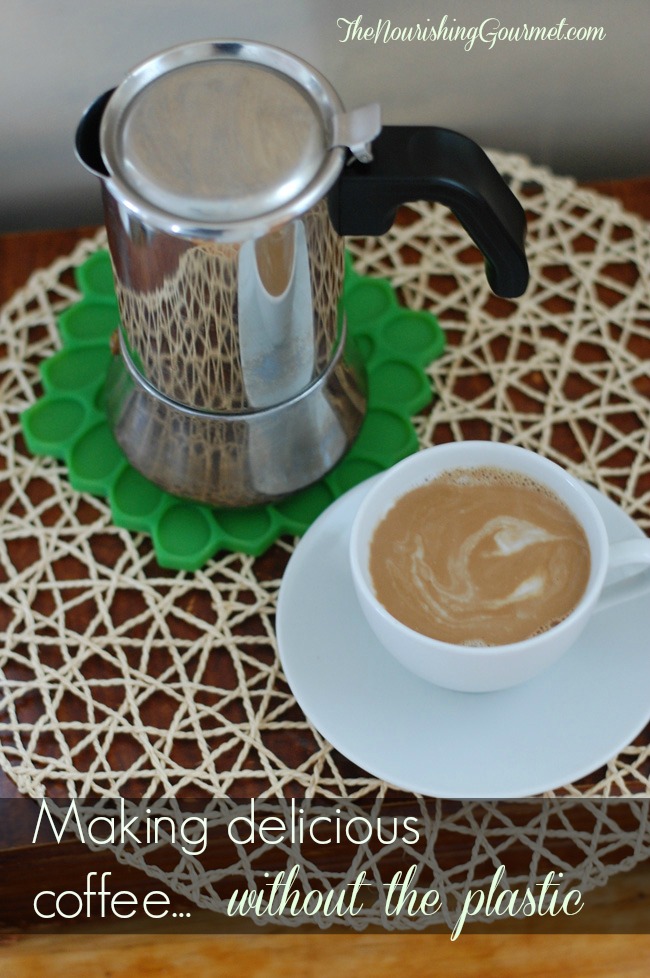
I happen to love coffee. This lovely bitter brew, with a swirl of coconut cream, helps start my day off right. But have you ever thought of possible chemical contamination swirling in your cup of jo? I don’t say that to be an alarmist or to be dramatic, but it does seem that many of us are adding to our chemical and toxin load through our coffee habit.
Many of us have made steps to remove plastic from our kitchens. But have you considered your coffee maker?
The Problem with Plastic
Plastic is made up of varying chemicals, many of which are known toxins. Two especially concerning ones are phthalates, and chemicals that mimic estrogen, such as BPA. Phthalates can leach into food and beverages and cause hormonal imbalances and birth defects, and they are unfortunately present in the blood of virtually everyone in the developed world. How does it migrate to what consume? By being heated.
BPA, and other similar chemicals in plastic, has been linked to a wide variety of possible health concerns, including breast cancer, reduced sperm counts, obesity, prostate cancer, and neurological problems in children. When scientists tested Americans for its presence, they found evidence that all of us are getting almost constant exposure to it.
When a lot of this information first came out some researchers were suggesting two things: Avoiding heating food or liquids in plastic, and switching to safer food storage containers such as glass, stainless steel, or ceramic.
Pouring boiling water through coffee grinds sitting in plastic seems like a bad idea.
In fact, in one recent story, a woman cured her perimenopausal symptoms and a sudden skin condition by ditching her coworkers regular coffee maker coffee for a cup made with a glass French press. If that sounds outlandish, consider the fact that studies have linked chemical exposure to early menopause and BPA from cans to increases in blood pressure.
While we can’t all have such dramatic results with one simple change in our habits, if one simple habit change could reduce our exposure significantly, my question is, why not?
Besides, if you like good coffee, the following methods are wonderful!
Let’s start with one of the cleanest options I’ve found that also happens to look elegant.
(Some links may be affiliate or partner links. Thanks for supporting my blog!)
Chemex Coffee Maker
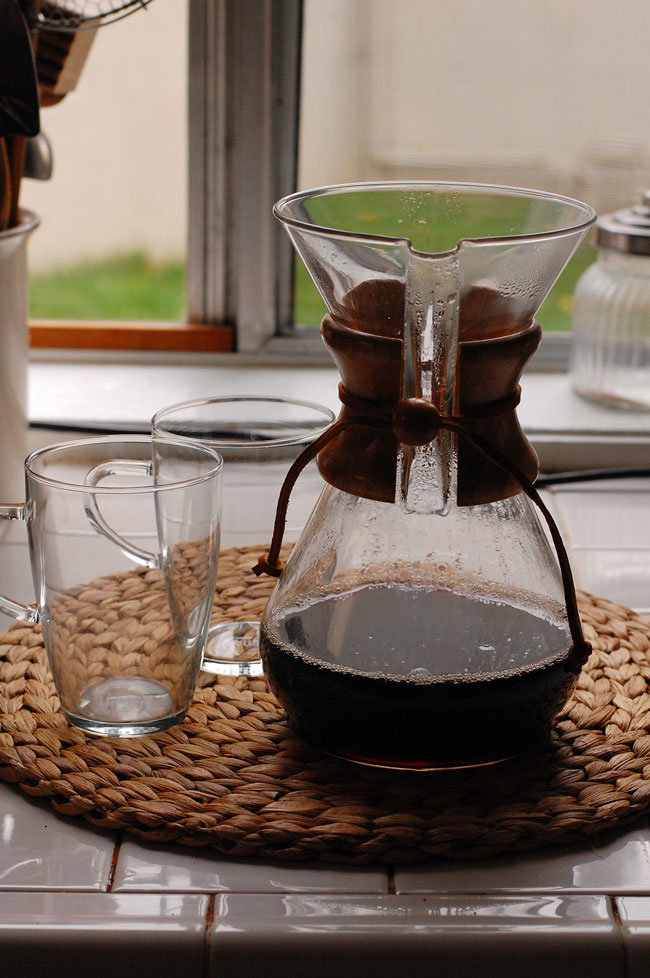
How to make: With special filters that fit at the top with the coffee grinds, you slowly pour water over the coffee grinds, until you’ve reached either of the indicated markings.
Pros:
- Super cool looking
- Made completely with glass and wood (A+ for avoiding plastic!)
- The act of being so involved with your coffee by slowly swirling hot water over coffee grinds makes it an art form (and also makes you look awesome when doing in front of guests).
Cons:
- You have to actively pour slowly, which takes some minutes to do. So this isn’t going to make your cup of coffee for you while you rush around getting the kids ready for school.
- Harder to make single servings
Another model that I haven’t tried is the Grosche Pour Over , which features a permanent stainless steel filter. Not quite as pretty in my opinion, but I love the stainless steel filter idea. For the Chemex Coffee Maker you can use unbleached filters , a stainless steel filter made by another brand to fit Chemex, or a cotton CoffeeSock .
If you really want to do it right, you can even buy this special kettle for heating water, which allows you to pour hot water evenly over the coffee dripper.
Single Cup Pour Over
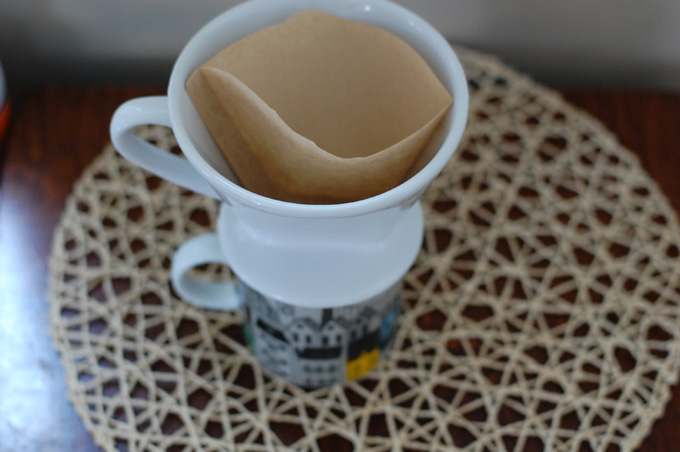 How to make: Put a heaping scoop of coffee grinds in filter in the coffee dripper, and slowly pour water through until the coffee cup has reached desired fullness.
How to make: Put a heaping scoop of coffee grinds in filter in the coffee dripper, and slowly pour water through until the coffee cup has reached desired fullness.
Pros:
- An easy way to make single serve coffee
- Small drawer/cupboard space for a coffee maker
- Is also completely plastic-free (that is, if you get the right coffee dripper!).
Cons:
- Can only make one cup at a time.
- You are actively involved in slowly pouring hot water
One of the most celebrated brands is Hario Coffee Drippers for pour over coffee. Avoid the plastic ones for obvious reasons. There is a ceramic version, and a glass version (this has a rim that seems to be made either with ceramic or plastic, I am not sure. It doesn’t touch the hot liquid, but steam may reach it), and a cooper one too (though I would be concerned with getting elevated copper levels with the regular use of this one).
French Press
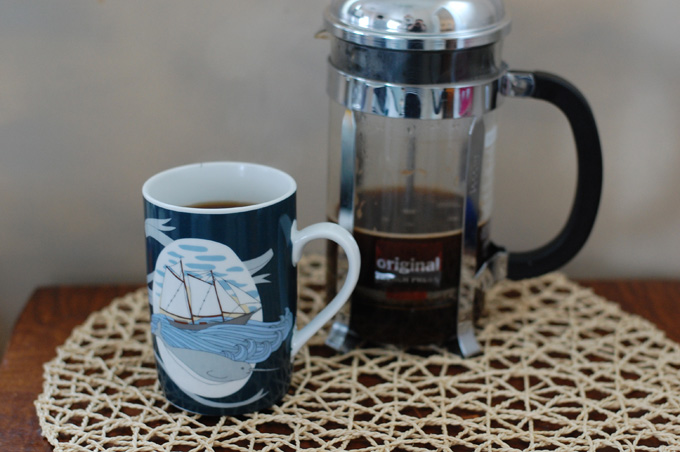
How to make: Measure coffee grinds and place in the bottom of the press. Fill with very hot water, and steep for 4-7 minutes. Press, and enjoy.
Pros:
- So easy! And while you have to pour the hot water in, it really is a painless and easy process.
- Makes lovely coffee
- You can use to make loose leaf tea as well!
Cons:
Not all presses are 100% plastic-free. I have this Bodum French Press . It DOESN’T have plastic down by the plunger, but some of their cheaper options do have a small piece of plastic. But it DOES have plastic on the lid (It shouldn’t touch the water, but obviously has hot water condensing on it). For a completely plastic-free French Press, you could try out this Frieling Stainless Steel Coffee Press , which is completely plastic-free, but be prepared to spend a whole lot more. However, keep in mind that it does have the added benefit of keeping the coffee warm for much longer.
StoveTop Espresso Maker
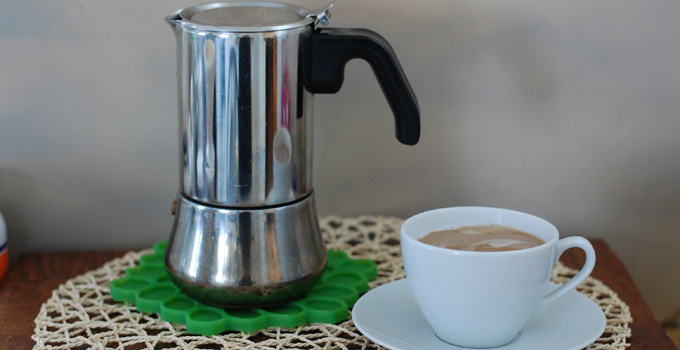
How to Make: The coffee grinds are put in the middle of the maker, with water in the bottom. High pressure pushes it up through the grinds, and you have the espresso at the top, ready to pour.
Pros:
- Espresso shots without an expensive espresso maker! While not quite the same quality as that made from an expensive espresso maker, it’s still quite good.
- Can make into lots of coffee drinks, but also use to make Americanos (made with boiling water, similar to regular coffee)
- Mostly hands off
Cons:
- You do have to watch it during the end of the process, so it doesn’t burn.
- Takes longer than the other options.
I own this Ikea Espresso Maker (buy from Ikea store, as it is overpriced on Amazon). Other beautiful Stainless Steel options include this Bialetti Espresso Maker , or this Cuisinox Espresso Maker . You can buy models in a variety of sizes to fit different needs.
And yes, I use and own all of the above. 🙂 Do you any any plastic free coffee methods to add? I’d love to hear!
Latest posts by KimiHarris (see all)
- 2 Ingredient Peppermint Bark - December 21, 2022
- Herbal Hibiscus Lemonade (Keto, THM) - March 16, 2022
- Creamy Curry Red Lentil Soup - December 8, 2021
I’m loving the article! I’m a tea drinker, but my husband loves coffee. It makes me happy to see that we have a nice stainless steel espresso maker. That way I don’t have to worry about these things has my husband has two cups a day lol
I love tea AND coffee. Makes it hard to choose sometimes. 😉 I’d love to hear what espresso maker you have!
Yum, I need to go make a cup of coffee. I have the same french press and espresso maker. I love them both! I really like the coffee from my friend’s Areopress but I’m not thrilled that it is plastic even if it claims to be safe.
Katie, I know! I’m so sad it is made out of plastic. When I was researching this issue (to make sure I was accurate in what I said above about plastics), I did find out that even BPA-free plastic can be a problem because other chemicals in the plastic can have the same estrogenic effect. 🙁
Made brownies for dessert & told my husband we needed coffee, too. He made a us a cup in a press that he has but there is some plastic on it. I have 2 French presses & 1 is all stainless. I use them for herbal tea all the time but enjoy them for coffee, too. We have a Chemex but I haven’t had much success with it. The coffee is not hot by the time it is finished dripping through. I’ve read that some who use it regularly have a kitchen scale & use that to measure out the coffee & water. I typically use the regular Mr. Coffee pot in the mornings because it’s the easiest. I have 7 littles and the youngest is 4 months. In the morning, I need easiest!! Any tips on using the Chemex successfully would be appreciated!
Micah,
It sounds like somehow the water is going through too slowly, as it shouldn’t be cold when you are done. I wonder if you are using coffee grinds that are too fine? Here are some really good directions on making it correctly., although I admit to not doing half the steps listed myself ;-). I don’t actually weigh anything. I DO find that the French press is the easiest and fastest for me personally, and also make the stovetop espresso fairly often too.
Silly question, but for these methods besides the expression maker you have to boil water for them right? I would love to switch from a coffee pot, but with a six month old I don’t always have the time and I know I would just end up not making coffee like I did when she was first born.
Yes, you do. I do find the French press method the most conducive to motherhood, but you still have to boil water. (I have a just turned 3 month old, and two older girls, and I generally get around to making myself a cup of coffee or tea in the morning, but end up drinking it standing up the whole time!)
We have the Bodum Press with the glass container. I heard that there is a new French Press model with a thermos container so coffee stays hot – which is my only complaint with the Glass French Press because I am too lazy to boil water all over again for a second cup. 🙂
Liz,
Nice! I just noticed that one now, I believe it’s this Bodum Stainless Steel one?
Apparently this does have plastic parts, although few.
How about the old fashioned percolator. Mine was glass and metal. It was electric and as automatic as a mr coffee. We resisted using the new types for years because the coffee made by them did not taste as good. Our pot finally gave out and we could not find a replacement. They require a different grind of coffee so it would not go through the basket. I still have a camp pot that can be used on the stove. It is aluminum and I have heard of concerns with that. I have heard there are companies that make percolators, don’t know who.
Hey Jim,
That’s a great question. I don’t currently own one, but some readers on Facebook suggested this Presto 12 cup Percolator , and say there is no plastic inside of it!
Hamilton Beach makes a great one…and you can use as much coffee/water as you need. Death to Keurigs! (Too harsh?)
I was going to buy the presto percolator until i found out it has aluminum in the bottom 🙁
MAX MATIC EC-120 I believe the number is
Is supposed to be ALL Stainless inside.
REPLACE their PLASTIC bubbler with a GLASS one
and you just might have something!>
You can buy a “FITZ-ALL” Glass Bubbler, on Amazon
There is an ALUMINUM ring that goes with it. I NEVER use their ICKY ring.
Instead if you don’t trust it to stay put as a screw-in bubbler then secure the UNDERSIDE of the bubbler (under the lid)
with STRONG stainless WIRE…my thoughts.
Hopefully it will make a decent cup of jo.
Using Organic RAW coffee beans and roasting them yourself is also another option
to get BETTER tasting coffee. The beans come in a grayish-green color.
Takes approx 11 minutes to slow-roast. Good info on the internet.
We use a stainless steel (NOT aluminum) popcorn crank popper on the stove to roast our coffee.
It is best if done the day before you want to use it. IMO
P.S. You MIGHT be able to find a CORNING GLASS percolator or a corning ELECTRIC percolator
online (ebay). Certain models were re-called…but NOT all of them
I was just going to ask you what you thought about a percolator. Mine is also stainless steel, made by Farberware. It makes very hot coffee in just a few minutes. I actually have a few different sizes, depending on how much I need to make for company. I was thinking that it was a way around the plastic. The percolators come in different sizes and they make the paper filters for them for those who want to use a filter. The ones that I own were purchased for a few dollars at garage sales.
When I am just making coffee for myself in the morning, I use a pour over. I heat the water in a small stainless steel pot that has a pouring spout on the side. It is quick and easy to heat the water and then just turn the pot over in my dish drainer to dry. Then, I only have to clean the pour over cup and that is quick and easy too.
As always, your posts are so helpful and informative. I appreciate the readers ideas too. I learn so much. Thank you for what you do. It really helps.
MOST of the older percolators had ALUMINUM stems & FILTER Baskets/lids.
So i am noticing on ebay…
They almost always had a PLASTIC bubbler….not too many older percolators
that have BOTH STAINLESS AND GLASS.
IF you could find an ALL stainless filter stem & basket/lid, you could change-out
the plastic bubbler for a GLASS one. They sell FITZ-ALL GLASS bubblers on Amazon.
DON’T use the ALUMINUM ring to secure it on the underside, use stainless steel wire or a SS LARGE washer
or get creative…but DON’T be tempted to use the aluminum piece
We use a Coleman stainless steel percolator, and it takes about 20 minutes, but it is so worth it. We started using it when our Bunn suddenly stopped working, and once we tasted the coffee, we knew we would never go back to an electric drip. Delicious coffee with no bitterness!
I grew up in a Hispanic household so we’ve always used steel percolators (:
Ecojarz Dose, for pour over coffee and tea on the go (especially when paired with their silicone lid and a jar cozy)!
MOST of us remember our parents using a percolator in the 50’s & 60’s. Part of that experience as a kid, was watching the coffee “POP” as it hit the top….THESE PRESTO percolators get good reviews…BUT
they could have just as easily added a GLASS bubbler at the top…but they failed to do so
Therefore, this will never be the coffee percolator of choice, for me
It also has aluminum at the bottom where the heating element is 🙁
Here’s the plastic free coffee pot I’m using: http://www.amazon.com/Presto-02811-12-Cup-Stainless-Coffee/dp/B00006IV0Q/ref=lp_289746_1_2?s=kitchen&ie=UTF8&qid=1435320314&sr=1-2
MOST of us remember our parents using a percolator in the 50’s & 60’s. Part of that experience as a kid, was watching the coffee “POP” as it hit the top….THESE PRESTO percolators get good reviews…BUT
they could have just as easily added a GLASS bubbler at the top…but they failed to do so
Therefore, this will never be the coffee percolator of choice, for me
Whats the deal with the silicone gasket in the stovetop espresso maker?! People claim food grade silicone is safe, but the verdict is still out. What are your thoughts? Thank You
That was an awesome blog. I am also crazy about coffee 😀
Don’t forget to buy fresh beans from a reputable roaster. I wouldn’t recommend roasting anything that doesn’t have the roast date labeled on the bag. You might have to look around in some smaller coffee shops to find what you like but it is worth it to me. My beans are never more than one month off roast because I buy them from a shop which roasts their own coffee.
Also worth mentioning is using a good grinder if you decide to buy whole bean coffee. If you don’t want to shell out at least a couple hundred on a grinder I believe it’s better to just have the beans ground for you at the store.
Very cool article! Now that more people are getting on board the ‘straw-free’ lifestyle, let’s hope the coffee community continues to find even more sustainable practices!
I bought a stainless steel French press on Amazon.ca for under $50. I have had it for 2 years now and it is still going strong.we love French press coffee. What I would like to know is what kind of packaging does your coffee come in? I would love to find coffee beans packaged in paper it would make great wrapping paper afterwards 🙂
after doing much, much ,much searching for a non plastic/non aluminum coffeemaker I bought the Bunn VP17-1 and I love it!! I also bought the optional Bunn stainless steel replacement funnel to replace the plastic one that comes with the unit. This is the smallest fully stainless steel unit available. it has only one warmer plate. google it for an image. bunn deserves kudos for their product. its not the prettiest unit but it is built like a tank and i expect to will it to my kids when i die. there are replacement parts sold everywhere for it.
I am very pleased with the unit! makes great coffee and its very fast and very easy to use! We flip the power on bar on that its connected to , it takes 10 min to heat the water up and the coffee is done in about 90 seconds (1/2 pot)!. We could leave it powered on but it will waste electricity keeping the water at the right temperature. We make anywhere from 1 large cup to 1/2 pot of coffee. Every coffee make is different. It took me a couple of brews to determine the amount of water and coffee for a 1 cup and and 1/2 pot coffee. cleanup is easy as the funnel has a steel wire liner inside that keeps the coffee filter from sticking to the funnel. next time you go to mcdonalds , tim hortons etc note they have a bunn. Not the low end crappy plastic consumer models that bunn has but the stainless commercial units. the vp17-1 is the only consumer/commercial unit that is not plumbed directly into the water supply. its a pour over.
we had the “stainless steel” presto percolator for years it was a messy cleanup, coffee was ok not great (likely due to the high temperature the coffee is subjected to). I later discovered that the tank was aluminum (alzheimers with your coffee anyone?) so it had to go. i wonder how many of the other percolators use aluminum or plastic to cut down on the cost? The VP17-1 cost more but it will last!